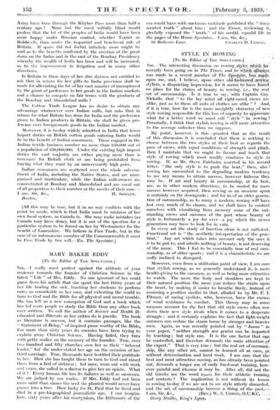STYLE IN ROWING •
[To the Editor of THE SPECTATOR.] . .
Stn,--The interesting discussion on mwing,Kyles: yelikbigs recently been going on in The Times, and Jo mlAc4441taliart was Made in 'a recent .inimber of The .SpecLettor, has Apple, upon me, and, I believe, 'upon' other obbashimmer..rp*g. stylists, a disquieting impression, for it seems to have found . no place for the claims of beauty in rowing, Le., the ,real. art of oarsmanship. Ts; it true to say, 'with Captain Guy Niekalls, that " to the lay mind 'all eight-Oared, crews are alike, just as to theni all suits of clothes are alike " _And, if it is true, how far is the More unsightly character of new style towing responsible for. this loss ofeapacity to appreciate what for a bettet word. we 'must call " style 7, in rowing.? PersOnally, I think that stylish rowing is still more attractive to the average onlooker than we suppose..
My point, however, is this—granted that as the result-- of this discussion it is concluded that there is nothing to . choose between the two styleS at their best as regards the pace of crews, with equal conditions of strength and Nook, then I maintain that we ought to favour and teach that style of rowing which most readily conduces to style iq rowing. If, as Mr. Steve Fairbairn asserted in his second letter, " the only style is to push the boat," then, alas ! roWing has succumbed to the degrading modern tendency, to ,die any means to attain success, 'hnwever hideous they, may be.' If art and beanty in oarsmanship, at its best, are, us in other modern directions, to be ousted for mere success however acquired, then rowing as an amateur sport , is certainly on the downgrade ; and for us of an older generm, tion of oarsmanship, as to many a modern; rowing will have, lost very much of its charm, and we shall have to content ourselves with visualizing' front memory some of the out, standing crews and oarsmen of the past whose beauty of style is fortunately a joy fbr ever—a joy which the newer generation may have to look for in vain.
In every art the study of function alone is not sufficient. Functional art is " the aesthetic interpretation of the pram' tical." Any art Which takes into, account only the uses it is to be put to, and admits nothing of beauty is not deserving of the name: This I feel to be essentially true of real oars- manship, as of other sporta ; and it is a charaCteristic we are sadly inclined to disregard.
Moreover, even from a utilitarian point of view, I am sure- that stylish rowing, as we generally understand it, is more health-giving to the oarsmen, as well as being more attractive to watch. The more the body and shoulders arc kept in their natural pasition the more you reduce the. strain upon the heat, by making it easier to breathe freely, instead of assuming a position similar to that, alluded to by Mr. F. I. Pitman, of racing cyclists, sito, however, have the excuse, of wind resistance to combat. This theory may in sonic measure account for the fact that old style crews often row down their new- style rivals when it comes to a desperate struggle ; and it certainly explains the fact that light-weight oarsmen can endure the, strain borne by stronger and heavier men. Again, as was recently pointed out by " Janus " in your paper, " neither strength nor genius can be imparted by teaching ; but style can. It is the one factor that clot be Controlled, and therefore demands the main attention'e the exPert." That is very true ; but the real art of oarsMatsi ship, 'like any other art, cannot be learned all at once, withOnf determination and bard work. I am sure that: the best and most attractive rowing, as has already been pointed out, demands a longer use of early fixed-seat. training, how-: ever painful and irksome it may be. After.all, did not the old Greeks use the word &yowl. for, their athletic training and contests? The implication is not without its lesson in rowing to-day if we are not to see style utterly. discarded, and the art of oarsmanship become a thing of the .past... _
I am, Sir, &c., (Rev,) Usiwist, : Oz:cry Stnithc,Hinge




































 Previous page
Previous page